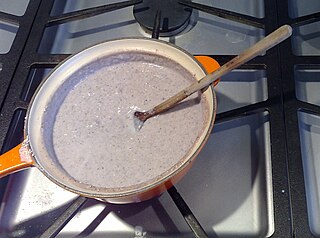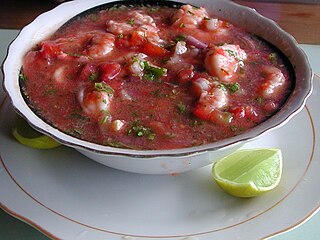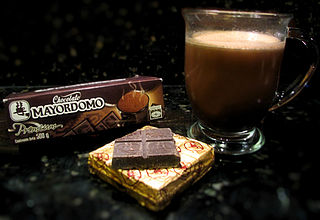Related Research Articles

Mexican cuisine consists of the cooking cuisines and traditions of the modern country of Mexico. Its earliest roots lie in Mesoamerican cuisine. Its ingredients and methods begin with the first agricultural communities such as the Maya who domesticated maize, created the standard process of maize nixtamalization, and established their foodways. Successive waves of other Mesoamerican groups brought with them their own cooking methods. These included: the Olmec, Teotihuacanos, Toltec, Huastec, Zapotec, Mixtec, Otomi, Purépecha, Totonac, Mazatec, Mazahua, and Nahua. With the Mexica formation of the multi-ethnic Triple Alliance, culinary foodways became infused.

Meatloaf is a dish of ground meat that has been combined with other ingredients and formed into the shape of a loaf, then baked or smoked. The final shape is either hand-formed on a baking tray, or pan-formed by cooking it in a loaf pan. It is usually made with ground beef, although ground lamb, pork, veal, venison, poultry, and seafood are also used, sometimes in combination. Vegetarian adaptations of meatloaf may use imitation meat or pulses.

Hot chocolate, also known as hot cocoa or drinking chocolate, is heated chocolate milk. Hot chocolate made with melted chocolate is sometimes called drinking chocolate, characterized by less sweetness and a thicker consistency.

Atole, also known as atolli and atol de elote, is a traditional hot corn- and masa-based beverage of Mexican origin. Chocolate atole is known as champurrado or atole. It typically accompanies tamales, and is very popular during Day of the Dead and Las Posadas.

White coffee can refer to any of a number of different kinds of coffees or coffee substitutes worldwide.

Barley tea is a roasted-grain-based infusion made from barley. It is a staple across many East Asian countries such as China, Japan, Korea and Taiwan. It has a toasty, bitter flavor.

Colombian cuisine is a compound of the culinary traditions of the six main regions within the country. Colombian cuisine varies regionally and is particularly influenced by Indigenous Colombian, Spanish, and African cuisines, with slight Arab influence in some regions. Furthermore, being one of the most biodiverse countries in the world, Colombia has one of the widest variety of available ingredients depending on the region.

Bsisa is a typical Mediterranean food, based on flour of roasted barley which dates back to Roman times.
Sattu is a type of flour, mainly used in Nepal, India, Bangladesh and Pakistan. It consists of a mixture of ground pulses and cereals. The dry powder is prepared in various ways as a principal or secondary ingredient of dishes. Sattu is used in vegetarian cuisine as it can be a source of protein.

Ecuadorian cuisine is diverse, varying with altitude, and associated agricultural conditions. Ecuadorian cuisine is an amalgamation of Spanish, Andean, and Amazonian cuisines and to a lesser degree Italian, Lebanese, African, and Chinese. Beef, chicken, and seafood are popular in the coastal regions and are typically served with carbohydrate-rich foods, such as rice accompanied with lentils, pasta, or plantain, whereas in the mountainous regions pork, chicken, beef and cuy are popular and are often served with rice, corn, or potatoes. A popular street food in mountainous regions is hornado, consisting of potatoes served with roasted pig. Some examples of Ecuadorian cuisine in general include patacones, llapingachos, and seco de chivo. A wide variety of fresh fruit is available, particularly at lower altitudes, including granadilla, passionfruit, naranjilla, several types of banana, uvilla, taxo, and tree tomato.

Mayordomo or Chocolate Mayordomo is a brand of Mexican chocolate para mesa produced by the company Chocolate Mayordomo De Oaxaca, S. De R.L. De C.V., and based in Oaxaca, Oaxaca, Mexico. The company manufactures mole sauce in addition to table chocolate.

Pozol is the name of both fermented corn dough and the cocoa drink made from it, which has its origins in Pre-Columbian Mexico. The drink is consumed in the south of Mexico in the states of Chiapas and Tabasco. It is a thirst-quencher which has also been used to fight diseases. It has also aided indigenous peoples of the Americas as sustenance on long trips across the jungles.
Inka is a Polish roasted grain drink. Developed in the late 1960s Inka has been produced in Skawina since 1971, a centre of coffee production since the early 20th century. Currently it is manufactured by GRANA Sp. Z O.O. While it was used in part as a coffee substitute to alleviate coffee shortages in the 1970s, Inka remains popular, in part because it is caffeine-free. It is exported to Canada and the United States as Naturalis Inka in packaging reminiscent of that used in Poland in the early 1990s.

Oaxacan cuisine is a regional cuisine of Mexico, centered on the city of Oaxaca, the capital of the state of the same name located in southern Mexico. Oaxaca is one of Mexico's major gastronomic, historical, and gastro-historical centers whose cuisine is known internationally. Like the rest of Mexican cuisine, Oaxacan food is based on staples such as corn, beans and chile peppers, but there is a great variety of other ingredients and food preparations due to the influence of the state's varied geography and indigenous cultures. Corn and many beans were first cultivated in Oaxaca. Well known features of the cuisine include ingredients such as chocolate, Oaxaca cheese, mezcal and grasshoppers (chapulines) with dishes such as tlayudas, Oaxacan style tamales and seven notable varieties of mole sauce. The cuisine has been praised and promoted by food experts such as Diana Kennedy and Rick Bayless and is part of the state's appeal for tourists.

The cuisine of Chiapas is a style of cooking centered on the Mexican state of the same name. Like the cuisine of rest of the country, it is based on corn with a mix of indigenous and European influences. It distinguishes itself by retaining most of its indigenous heritage, including the use of the chipilín herb in tamales and soups, used nowhere else in Mexico. However, while it does use some chili peppers, including the very hot simojovel, it does not use it as much as other Mexican regional cuisines, preferring slightly sweet seasoning to its main dishes. Large regions of the state are suitable for grazing and the cuisine reflects this with meat, especially beef and the production of cheese. The most important dish is the tamal, with many varieties created through the state as well as dishes such as chanfaina, similar to menudo and sopa de pan. Although it has been promoted by the state of Chiapas for tourism purposes as well as some chefs, it is not as well known as other Mexican cuisine, such as that of neighboring Oaxaca.
Mole blanco is a type of mole of the cuisine of Mexico. This type of thickened sauce is prepared with a mixture of the ingredients lightly roasted, including: peanuts without skin, skinless almonds, sunflower, pine nuts and white corn tortilla. The elements fried in oil are sliced banana, chopped apple, blonde raisins, sliced onion, pieces of chile güero and bits of habanero chile. These ingredients are then ground in a blender or in a molcajete, adding milk, white chocolate, and water or broth, along with seasoning items like garlic, cloves, allspice, cinnamon strips and anise. An aromatic mole is obtained, with mildish flavour.

Tsokolate, also spelled chocolate, is a native Filipino thick hot chocolate drink. It is made from tabliya or tablea, tablets of pure ground roasted cacao beans, dissolved in water and milk. Like in Spanish and Mexican versions of hot chocolate, the drink is traditionally made in a tsokolatera and briskly mixed with a wooden baton called the molinillo, causing the drink to be characteristically frothy. Tsokolate is typically sweetened with a bit of muscovado sugar, and has a distinctive grainy texture.
References
- ↑ Guitiérrez, Tuxla. "El tascalate, una bebida con sabor a Chiapas". El Universal. Retrieved 2 February 2015.
